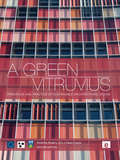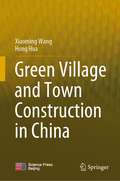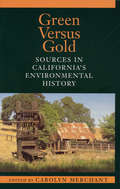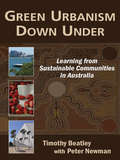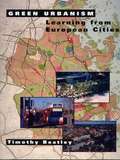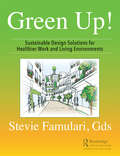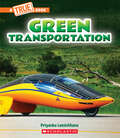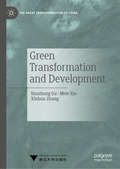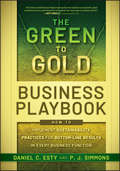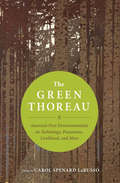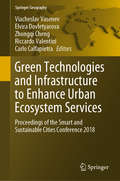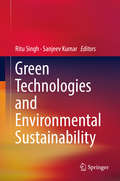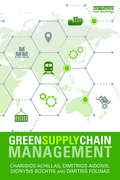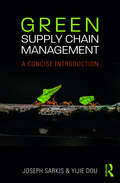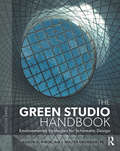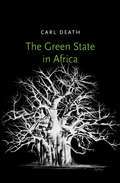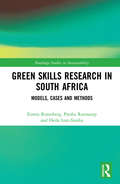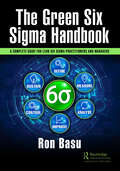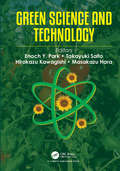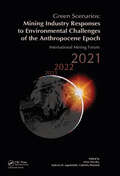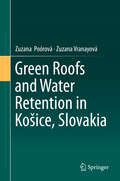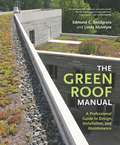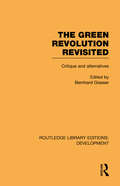- Table View
- List View
A Green Vitruvius: Principles and Practice of Sustainable Architectural Design
by Vivienne Brophy J Owen Lewis2000 years ago the roman architect Marcus Vitruvius Pollio wrote the ten books on architecture establishing the concept of the pattern book offering design principles and solutions that is still referred to in every architect's education. A Green Vitruvius is intended as a green pattern book for today. Now fully updated, this well established textbook provides advice suitable for undergraduate and post graduate students on the integration of sustainable practice into the design and construction process, the issues to be considered, the strategies to be adopted, the elements of green design and design evaluation within the process. Classic design elegance is found in the holistic clear solution.
Green Village and Town Construction in China
by Xiaoming Wang Hong HuaBy means of multidisciplinary research on urban and rural planning, construction engineering, environmental engineering and engineering sociology, this book conducts pioneering research on the construction theory, construction methods, evaluation technology and application of demonstration projects in China’s green villages and towns. The book is divided into three parts and eleven chapters. Part I is about the theory and development of green village and town construction, including the theory and innovation, the evolution and development, the patterns and mechanisms, and the community of green village and town construction. Part II is about the planning and construction methods of green villages and towns, including the plan compilation, the environmental infrastructure construction, and the construction and renovation of green buildings in villages and towns. Part III is about the evaluation of the planning and construction of green villages and towns, including the evaluation of plans, the evaluation of environmental infrastructure construction, the evaluation of green building construction, and the comprehensive evaluation of the planning and construction of green villages and towns. Today, 564 million farmers live in 28,500 towns and 2.452 million villages in China. In 2018 alone, 820 million m2 of new houses were built in rural areas. This proves that China’s green village and town construction has great significance and can provide enlightenment to developing countries and even to the world. The book describes new theories, new perspectives and new methods of green village and town sustainable construction in China for overseas experts and readers.
Green Versus Gold: Sources In California's Environmental History
by Carolyn MerchantWhile the state of California remains one of the most striking and varied landscapes in the world, it has experienced monumental changes since European settlers first set foot there. The past two centuries have witnessed an ongoing struggle between environment and economy, nature and humanity that has left an indelible mark on the region.Green Versus Gold provides a compelling look at California's environmental history from its Native American past to conflicts and movements of recent decades. Acclaimed environmental historian Carolyn Merchant has brought together a vast storehouse of primary sources and interpretive essays to create a comprehensive picture of the history of ecological and human interactions in one of the nation's most diverse and resource-rich states.For each chapter, Merchant has selected original documents that give readers an eyewitness account of specific environments and periods, along with essays from leading historians, geographers, scientists, and other experts that provide context and analysis for the documents. In addition, she presents a list of further readings of both primary and secondary sources. Among other topics, chapters examine:California's natural environment and Native American lands the Spanish and Russian frontiers environmental impacts of the gold rush the transformation of forests and rangelands agriculture and irrigation cities and urban issues the rise of environmental science and contemporary environmental movement.Merchant's informed and well-chosen selections present a unique view of decades of environmental change and controversy. Historians, educators, environmentalists, writers, students, scientists, policy makers, and others will find the book an enlightening and important contribution to the debate over our nation's environmental history.
Green Urbanism Down Under: Learning from Sustainable Communities in Australia
by Timothy Beatley Peter NewmanIn this immensely practical book, Timothy Beatley sets out to answer a simple question: what can Americans learn from Australians about "greening" city life? Green Urbanism Down Under reports on the current state of "sustainability practice" in Australia and the many lessons that U.S. residents can learn from the best Australian programs and initiatives. Australia is similar to the United States in many ways, especially in its "energy footprint." For example, Australia's per capita greenhouse gas emissions are second only to those of the United States. A similar percentage of its residents live in cities (85 percent in Australia vs. 80 percent in the United States). And it suffers from parallel problems of air and water pollution, a national dependence on automobiles, and high fossil fuel consumption. Still, after traveling throughout Australia, Beatley finds that there are myriad creative responses to these problems--and that they offer instructive examples for the United States. Green Urbanism Down Under is a very readable collection of solutions. Although many of these innovative solutions are little-known outside Australia, they all present practical possibilities for U.S. cities. Beatley describes "green transport" projects, "city farms," renewable energy plans, green living programs, and much more. He considers a host of public policy initiatives and scrutinizes regional and state planning efforts for answers. In closing, he shares his impressions about how Australian results might be applied to U.S. problems. This is a unique book: hopeful, constructive, and filled with ideas that have been proven to work. It is a "must read" for anyone who cares about the future of American cities.
Green Urbanism: Learning From European Cities
by Timothy BeatleyAs the need to confront unplanned growth increases, planners and policymakers scramble for practical tools and examples of successful and workable approaches. Growth management initiatives are underway in the US, but many American "success stories" provide only one piece of the puzzle. To find examples of a holistic approach to dealing with sprawl, one must turn to models outside of the United States.In Green Urbanism, Timothy Beatley explains what planners and local officials in the United States can learn from the sustainable city movement in Europe. The book explores the progress and policies of twenty-five of the most innovative cities in eleven European countries. Chapters examine:*the sustainable cities movement in Europe*examples of different housing and living options*policies for promoting transit and bicycle use and minimizing the role of the automobile*creative ways of incorporating greenness into cities*ways of readjusting "urban metabolism" so that waste flows become circular*programs to promote more sustainable forms of economic development*sustainable design measures and features*renewable energy initiatives and local efforts to promote solar energy*ways of greening local government decisions including ecological budgeting, green accounting, and other city management tools.Throughout, Beatley focuses on the key lessons from these cities -- including Vienna, Helsinki, Copenhagen, Stockholm, Zurich, Amsterdam, London, and Berlin -- and what their experience can teach us about effectively promoting sustainable development in the United States. Green Urbanism is the first full-length book to describe urban sustainability in European cities, and provides concrete examples and detailed discussions of innovative and practical sustainable planning ideas.
Green Up!: Sustainable Design Solutions for Healthier Work and Living Environments
by Stevie FamulariThere are unique greening solutions and practices that help create a lifestyle shift, improving the health of living and working spaces for its occupants from a personal, business, environmental, and profitable perspective. Short-term and long-term considerations are important elements when moving forward towards healthy practices in lifestyles, choices, and site designs. This book addresses a myriad of greening practices that can be applied to structures in our urban, suburban, and rural cultures. From the loft to the neighborhood, the office spaces to the public spaces, and the schools to the communities, this book outlines how business owners and residents can integrate scale appropriate green solutions into their lifestyles. Green Up!: Sustainable Design Solutions for Healthier Work and Living Environments includes detailed illustrations and photographs to help you understand design opportunities for your space. Stevie Famulari provides unique insights and inspires business owners, residents, and planners to develop their own green understanding and design solutions. Illustrations and photographs of applied greening are included throughout the book to help inspire your own goals and design, and then transform them to reality. The author breaks down the misconceptions of the complexity of sustainability and green practices. Greening is a lifestyle change, and this step-by-step instruction guide lets you know how easy it is to transition to the green side!
Green Transportation (A True Book (Relaunch))
by Priyanka LamichhaneEnvision a brighter future with this STEM-based subset of True Books.Electric cars. Solar-powered planes. Poop-fueled trucks. Each of these technological advances in transportation is bringing us ever closer to a green future, and more are being developed all the time. Considering how many vehicles are on our roads = and in the water and air = sustainable transportation might be the most important innovation we can make to ensure our planet's future. Learn how in Green Transportation.ABOUT THE SERIES:What would a green future look like? Will trains and airplanes be powered by the sun? Will we have homes that have zero impact on the environment? The most pressing challenge facing us today is how to ensure a healthy Earth for ourselves and future generations. This STEM-based set of A True Books introduces students to the engineering innovations that can help us reach those goals. Interesting information is presented in a fun, friendly way = and in the simplest terms possible = and will inspire kids to start envisioning and enacting a more sustainable future.
Green Transformation and Development (The Great Transformation of China)
by Shuzhong Gu Meie Xie Xinhua ZhangThis book offers an insiders' view into Chinese plans for a green transformation of the economy of China. Analyzing the pressures, drive, and resistance to this green transformation in China, the book explores the key fields, from green finance and green banking to green consumption and green urbanization. Furthermore, it offers a guide on how government officials will be penalized or rewarded for their successful furtherance of green objectives. This book will be of interest to climate activists, China watchers, architects, and all those invested in a sustainable future.
The Green to Gold Business Playbook: How to Implement Sustainability Practices for Bottom-Line Results in Every Business Function
by Daniel C. Esty P. J. Simmons"Implement the green strategies outlined in Dan Esty's and Andrew Winston's bestseller Green to Gold"Hard-nosed business advice for gaining competitive advantage through sustainability action in buildings and operations, information technology, product design, sourcing, manufacturing, logistics and transportation, marketing, accounting, and other key business functionsWhether you are a climate change skeptic or an environmentalist, sustainability issues cannot be ignored in today's corporate world. With rising energy and natural resource costs, intensified regulations, investor pressures, and a growing demand for environmentally friendly products, sustainability is no longer an option--it's a business imperative.Unlike many green business books, the Playbook skips the environmental ideology and deals exclusively with tools and strategies that have been shown to cut costs, reduce risks, drive revenues, and build brand identity.Builds on Dan Esty and Andrew Winston's prizewinning Green to Gold, which has become a business classic and a staple of management training across the world.Shows in detail how each business function or department can achieve an eco-advantage over the competitionOffers frameworks, checklists, and action plans applicable to any business-big or small, in manufacturing or servicesThe Green to Gold Business Playbook gives you the tools to make green work-and work profitably-for your business.
The Green Thoreau
by Carol Spenard Larusso Henry David ThoreauHenry David Thoreau saw nature as teacher and companion, and many of his philosophies guide the contemporary environmental movement. What Thoreau wrote about simplicity, materialism, technology, and our troubled relationship with nature is perhaps even more relevant to our lives today than it was in the nineteenth century. In these pages, editor Carol Spenard LaRusso presents quotations by Thoreau on nature, technology, livelihood, living, possessions, time, diet and food, and aspiration. At turns passionate, funny, and profound, this collection serves as a compelling introduction -- or vivid reminder -- of why Thoreau is one of America's iconoclastic greats.
Green This! Volume 1
by Deirdre ImusChange the way you clean and keep your family's home wholesome and healthy with the help of expert and activist Deirdre Imus. We all grew up thinking chemical smells like bleach and ammonia signaled "clean." But as Deirdre Imus reveals, some of the chemicals we use to maintain our homes are doing us and our families much more harm than good. In Greening Your Cleaning, the first in her Green This! series, Deirdre shows how cleaning house the environmentally responsible way can be as effective and often cheaper than the more traditional, toxic, means. This volume includes: Simple, efficient cleaning methods for every room of the house Spotlights on everyday products (all purpose cleaner, glass/window cleaner, laundry detergent) and the toxic ingredients you should be wary of Summaries of the latest research on the toxic effects of ordinary chemicals Resource lists of widely available "green cleaning" products and retailers Filled with tips and testimonials, Greening Your Cleaning will show you how to streamline your cleaning products and practices, and how easy it is to make "living green" your way of life.
Green Technologies and Infrastructure to Enhance Urban Ecosystem Services: Proceedings of the Smart and Sustainable Cities Conference 2018 (Springer Geography)
by Viacheslav Vasenev Elvira Dovletyarova Zhongqi Cheng Riccardo Valentini Carlo CalfapietraThese proceedings of the Smart and Sustainable Cities Conference (SSC) in Moscow from May 23 to 26, 2018 addresses important questions regarding the global trend of urbanization. What are the environmental consequences of megacities’ expansion? What smart solutions can make life in cities safe, comfortable and environmentally friendly? It is projected that 70% of the global population will live in cities by 2050, and as such the book describes how this rapid urbanization will alter the face of the world. Focusing on solutions for the environmental problems of modern megapolises, it discusses advanced approaches and smart technologies to monitor, model and assess the environmental consequences and risks. The contributors present examples of successful sustainable urban development, including management and design of green infrastructure, waste management, run-off purification and remediation of urban soils. The SSC conference and its proceedings offer a valuable contribution to sustainable urban development, and are of interest to the scientific and research community, municipal services, environmental protection agencies, landscape architects, civil engineers, policy makers and other stakeholders in urban management and greenery.
Green Technologies and Environmental Sustainability
by Sanjeev Kumar Ritu SinghIn the present scenario, green technologies are playing significant role in changing the course of nation's economic growth towards sustainability and providing an alternative socio-economic model that will enable present and future generations to live in a clean and healthy environment, in harmony with nature. Green technology, which is also known as clean technology, refers to the development and extension of processes, practices, and applications that improve or replace the existing technologies facilitating society to meet their own needs while substantially decreasing the impact of human on the planet, and reducing environmental risks and ecological scarcities. The concepts of Green Technologies, if endorsed and pervaded into the lives of all societies, will facilitate the aim of the Millennium Development Goals of keeping the environment intact and improve it for the civilization to survive. Green Technologies and Environmental Sustainability is focused on the goals of green technologies which are becoming increasingly important for ensuring sustainability. This book provides different perspectives of green technology in sectors like energy, agriculture, waste management and economics and contains recent advancements made towards sustainable development in the field of bioenergy, nanotechnology, green chemistry, bioremediation, degraded land reclamation. This book is written for a large and broad readership, including researchers, scientists, academicians and readers from diverse backgrounds across various fields such as nanotechnology, chemistry, agriculture, environmental science, water engineering, waste management and energy. It could also serve as a reference book for graduates and post-graduate students, faculties, environmentalist and industrial personnel who are working in the area of green technologies.
Green Supply Chain Management
by Dimitris Folinas Dimitrios Aidonis Dionysis D. Bochtis Charisios AchillasToday, one of the top priorities of an organization’s modern corporate strategy is to portray itself as socially responsible and environmentally sustainable. As a focal point of sustainability initiatives, green supply chain management has emerged as a key strategy that can provide competitive advantages with significant parallel gains for company profitability. In designing a green supply chain, the intent is the adoption of comprehensive and cross-business sustainability principles, from the product conception stage to the end-of-life stage. In this context, green initiatives relate to tangible and intangible corporate benefits. Sustainability reports from numerous companies reveal that greening their supply chains has helped reduce operating cost, thus boosting effectiveness and efficiency while increasing sustainability of the business. Green Supply Chain Management provides a strategic overview of sustainable supply chain management, shedding light on the theoretical background and key principles of the topic. Specifically, this book covers various thematic areas including benefits and impact of green supply chain management; enablers and barriers on supply chain operations; inbound and outbound logistics considerations; and production, packaging and reverse logistics under the notion of "greening". The ultimate aim of this textbook is to highlight the challenges in the implementation of green supply chain management in modern companies and to provide a roadmap for decision-making in real-life cases. Combining chapter summaries and discussion questions, this book provides an accessible and student-friendly introduction to green supply change management and will be of great interest to students, scholars and practitioners in the fields of sustainable business and supply chain management.
Green Supply Chain Management: A Concise Introduction
by Joseph Sarkis Yijie DouThis book gives students a thorough overview of the environmental issues that impact the supply chain and details strategic methods of addressing the political, social, technological, market, and economic concerns that have caused organizations to reconsider their impact. Readers will learn how to integrate the fields of operations management, procurement and purchasing, logistics, and marketing into a successful green supply chain, looking outward to form sustainable partnerships rather than focusing their efforts within the company. Each chapter describes a function or dimension of green supply chains, supplemented with short vignettes to ground the theory in practice. The authors examine various industries, including electronics, food products, and manufacturing, and draw on case studies from the Americas, Europe, Asia, and Oceania, allowing students to compare and contrast domestic and international practices. Blending industry insights with the latest academic thinking, they also consider hot button topics like global–local relationships, the role of third parties, green multitier supplier management, and blockchain technology management. Conclusive chapter summaries and plenty of visual aids help readers retain the information they need to improve environmental performance within, and beyond their organizations. Green Supply Chain Management is an excellent introduction to the topic for students and practitioners of supply chain management and environmental sustainability.
The Green Studio Handbook: Environmental Strategies for Schematic Design
by Alison G Kwok Walter GrondzikThe Green Studio Handbook remains an essential resource for design studios and professional practice. This extensive and user-friendly tool presents practical guidelines for the application of green strategies during the schematic design of buildings. Students and professionals can quickly get up to speed on system viability and sizing. Each of forty-three environmental strategies includes a brief description of principles and concepts, step-by-step guidance for integrating the strategy during the early stages of design, annotated tables and charts to assist with preliminary sizing, key issues to consider when implementing the strategy, and pointers to further resources. Ten new in-depth case studies illustrate diverse and successful green buildings integrated design projects and how the whole process comes together This third edition features updated tables and charts that will help to save energy, water, and material resources during the early stages of design. More than 500 sketches and full-color images illustrate how to successfully apply strategies. A glossary, a project index listing 105 buildings in 20 countries, updated tables and drawings, and I-P and SI units increase the usefulness of The Green Studio Handbook.
The Green State in Africa
by Carl DeathA provocative reassessment of the relationship between states and environmental politics in Africa From climate-related risks such as crop failure and famine to longer-term concerns about sustainable urbanization, environmental justice, and biodiversity conservation, African states face a range of environmental issues. As Carl Death demonstrates, the ways in which they are addressing them have important political ramifications, and challenge current understandings of green politics. Death draws on almost a decade of research to reveal how central African environmental politics are to the transformation of African states.
Green Skills Research in South Africa: Models, Cases and Methods (Routledge Studies in Sustainability)
by Eureta Rosenberg Presha Ramsarup Heila Lotz-SisitkaThis book proposes transformative, realist methodology for skills research and planning through an analysis of case studies of the changing world of work, new learning pathways and educational system challenges. Studies of the green economy and sustainability transitions are a growing field internationally, however there are few books that link this interest to the development of skills. This book draws on, and showcases, the experience and insights of researcher-practitioners who are at the cutting edge in this emerging field, internationally and in South Africa. The context for this book is South Africa, but application is worldwide. In many ways indicative of the global picture, South Africa is in the grip of economic and environmental imperatives, searching for safe and just transitions. The authors present a new, embedded transitioning systems model for studying skills for a sustainable, just future. This book will be of great interest to students and scholars of sustainable development, ecological economics and skills planning.
The Green Six Sigma Handbook: A Complete Guide for Lean Six Sigma Practitioners and Managers
by Ron BasuThis book is a hands-on single-source reference of tools, techniques, and processes integrating both Lean and Six Sigma. This comprehensive handbook provides up-to-date guidance on how to use these tools and processes in different settings, such as start-up companies and stalled projects, as well as establish enterprises where the ongoing drive is to improve processes, profitability, and long-term growth. It contains the "hard" Six Sigma approach as well as the flexible approach of FIT SIGMA, which is adaptable to manufacturing and service industries and also public sector organisations. You will also discover how climate change initiatives can be accelerated to sustainable outcomes by the holistic approach of Green Six Sigma. The book is about what we can do now with leadership, training, and teamwork in every sphere of our businesses. Lean, originally developed by Toyota, is a set of processes and tools aimed at minimising wastes. Six Sigma provides a set of data-driven techniques to minimise defects and improve processes. Integrating these two approaches provides a comprehensive and proven approach that can transform an organisation. To make change happen, we need both digital tools and analog approaches. We know that there has been a continuous push to generate newer approaches to operational excellence, such as Total Quality Management, Six Sigma, Lean Sigma, Lean Six Sigma, and FIT SIGMA. It is vital that we harness all our tools and resources to regenerate the economy after the Covid-19 pandemic and make climate change initiatives successful for the survival of our planet. Six Sigma and its hybrids (e.g., Lean Six Sigma) should also play a significant part. Over the last three decades, operational performance levels of both public sector and private sector organisations improved significantly and Lean Six Sigma has also acted as a powerful change agent. We urgently need an updated version of these tools and approaches. The Green Six Sigma Handbook not only applies appropriate Lean and Six Sigma tools and approaches, fitness for the purpose, but it aims at sustainable changes. This goal of sustainability is a stable bridge between Lean Six Sigma and climate change initiatives. Hence, when the tools and approaches of Lean Six Sigma are focused and adapted primarily to climate change demands, we get Green Six Sigma.
Green Science and Technology
by Enoch Y. Park Takayuki Saito Hirokazu Kawagishi Masakazu HaraThis book provides a comprehensive and up-to-date review of recent trends of green science and technology. Worldwide deterioration of environment and global warming threaten our lifestyle and the survival of all creatures. In order to weather these problems, we need to construct a multidisciplinary approach involving the fusion of various advanced researches. The book begins with an overview on fundamental research about generation and utilization of renewable energy, protection of the earth's ecosystem for better coexistence with nature, development of artificial intelligence-based agriculture and molecular recognitionbased welfare and covers a wide range of innovative research on green science and technology.
Green Scenarios: International Mining Forum 2021
by Artur DyczkoThis book aims to present an alternative based on natural processes and an environmental approach to post-excavation site management, e.g., post-coal mining heaps. These sites are places where various mineral excavation by-products are collected. Nevertheless, some post-mineral excavation sites are oligotrophic, terrestrial, wetland, and water habitat islands, providing unique biodiversity enrichment in the landscape. These oligotrophic mineral habitats are essential in over-fertilized, eutrophic, agricultural and urban-industry surroundings. Some post-mineral excavation sites are places where the wildlife can develop and support the functional processes of novel ecosystems. Implementing the newest biogeochemical and comprehensive knowledge into urban-industry landscape management will help to establish the ecosystem’s processes and environmental functioning.There are several post-industrial sites in Europe where the wildlife areas developed due to natural processes, are becoming wildlife hotspots in densely populated urban-industry areas. In this respect, many of the oligotrophic mineral terrestrial, wetland, and water habitats of anthropogenic origin should not be categorized as environmentally dangerous and undergo economic utility-focused reclamation.Facing the actual environmental constraints of the Anthropocene Epoch, the book’s chapters presenting the natural basics and perquisites of the environmental ecosystem mosaics, will be interesting for a broad range of environmentalists (scientists and students), miners, economists, and sociologists.
Green Roofs and Water Retention in Košice, Slovakia
by Zuzana Poórová Zuzana VranayováThis book discusses how climate change and heat islands are a main contributor to water related problems in urban areas in Košice, Slovakia. Green roofs are used as a tool to assist in solving these water related issues. The need to provide housing in urban areas is expected to rise to 66% in 2050, according to the United Nations. Many urban areas have seen natural permeable green areas replaced with concrete constructions and hard, non-permeable surfaces. The densification of existing built-up areas is responsible for the decreasing vegetation, which results in the lack of evapotranspiration cooling the air, thereby creating urban heat islands. Several studies, discussed in this book, have shown that natural and permeable surfaces, as in the case of green roofs, can play a crucial role in mitigating this negative climate phenomenon and providing higher efficiency for buildings, leading to savings such as water, one of the focal points of this research.
Green Roof Retrofit: Building Urban Resilience
by Sara J. Wilkinson Tim DixonA deep understanding of the implications of green roof retrofit is required amongst students and practitioners to make the decisions and take the actions needed to mitigate climate changes. Green Roof Retrofit: building urban resilience illustrates the processes undertaken to develop this new knowledge and thereby embed a deeper level of understanding in readers.Illustrative case studies and exemplars are drawn from countries outside of the core researched areas to demonstrate the application of the knowledge more broadly. Examples are used from the Americas (North and South and Canada), Oceania, Asia and other European countries.The book describes the multiple criteria which inform decision making and how this provides a way forward for making better decisions about green roof retrofit in different countries and climates.
The Green Roof Manual: A Professional Guide to Design, Installation, and Maintenance
by Linda McIntyre Edmund C. SnodgrassGreen roofs—the ultimate in sustainable building practices—continue to generate enormous interest and enthusiasm among architects, landscape designers, and urban planners. Increasingly strict stormwater regulations and the appeal of LEED-related projects have also boosted the popularity and desirability of green roofs. Those who want to build green roofs, however, have few resources to guide them. Until now, no book has taken a comprehensive look at how to effectively adapt green-roof technology to the variable and extreme North American climate, and how to design projects that will function and endure as successfully as those in Germany, Switzerland, and other European countries. This book fills the gap by providing an overview of practices and techniques that have been effective in North America. The authors offer options regarding structure, function, horticulture, and logistics, as well as surveys of actual projects and analyses of why they have or haven’t succeeded. Approachable and reader-friendly, the manual clearly explains how these complex systems function and how to plan and carry out projects successfully from concept through construction and maintenance. Ideally suited to professionals (including architects, landscape architects, engineers, and designers) and their clients, it brings together key lessons from leaders in the field. Numerous photographs highlight the range of design possibilities and show green roofs both during construction and at various stages of maturity. At last, those seeking basic information about how to design and build green roofs have a concise, authoritative guide to this exciting new technology.
The Green Revolution Revisited: Critique and Alternatives (Routledge Library Editions: Development)
by Bernhard GlaeserThe Green Revolution – the apparently miraculous increase in cereal crop yields achieved in the 1960s – came under severe criticism in the 1970s because of its demands for optimal irrigation, intensive use of fertilisers and pesticides; its damaging impact on social structures; and its monoculture approach. The early 1980s saw a concerted approach to many of these criticisms under the auspices of Consultative Group on International Agricultural Research (CGIAR). This book, first published in 1987, analyses the recent achievements of the CGIAR and examines the Green Revolution concept in South America, Asia and Africa, from an ‘ecodevelopment’ standpoint, with particular regard to the plight of the rural poor. The work is characterised by a concern for the ecological and social dimensions of agricultural development,which puts the emphasis on culturally compatible, labour absorbing and environmentally sustainable food production which will serve the long term needs of developing countries.
